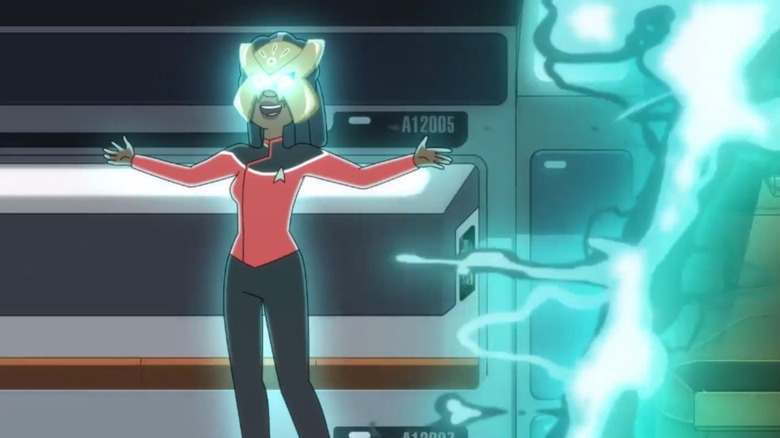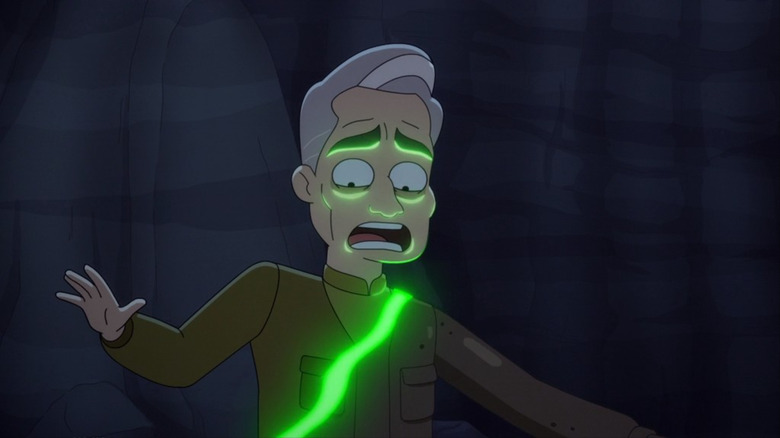In Praise Of Star Trek: Lower Decks Season 3's Brilliant Cold Opens
The fourth episode of the third season of "Star Trek: Lower Decks" sees the show's four protagonists sitting in a hallway that also serves as their quarters. Being an ensign aboard the U.S.S. Cerritos, as the show repeatedly states, kind of sucks. Officers sleep in hallway bunks and have no privacy. Ensign Mariner (Tawney Newsome) claims that close quarters aren't usually an issue for her, but seeing too many co-workers in short towels is growing tiresome. Ensign Boimler (Jack Quaid), optimistic, claims that the overcrowded conditions are merely the exciting bustle of life on a starship.
Just then, Captain Freeman (Dawnn Lewis) appears at the end of the hallway, emitting blue light, and hovering a meter off the ground. She wears a mask and speaks in a demonic voice. Crackling energy bolts follow her, turning the corridor of the ship into and ancient stone passages coated with creeping jungle vines. Mariner rolls her eyes at the terrifying sight and yells at the captain to stop touching masks. This is life on the Cerritos. Occasionally, your quarters will be turned into a stone temple.
This cold opening is, of course, a reference to the "Star Trek: The Next Generation" episode "Masks" (February 21, 1994) an episode where an ancient, spacebound artifact begins altering the Enterprise into the stone and organic matter from its ancient database. Data (Brent Spiner) puts on a mask and become "possessed" by the spirt of Masaka, a wrathful sun deity. Picard (Patrick Stewart) puts on a mask and poses as her rival Korgano, the god of the moon. 'Masks" is often called one of the worst episodes of the show.
One must admire the chutzpah of the "Lower Decks" writers to drop audiences into "Masks."
The cold opens
Indeed, this season of "Lower Decks" seems to be nailing the art of the cold open. For those unfamiliar with the term, a cold open is an TV episode's prelude that, prior to the opening credits sequence, sets up the action to come. Sometimes the cold open plays directly into the plot, although with the latest episode, called "Room for Growth," the opening mayhem is only tangentially related to the central story. "Room for Growth" is ultimately about a lottery played by the ship's ensigns to acquire private quarters of their own. The "Masks" references were just an example of how uncomfortable the living situation on the Cerritos is.
Of course, not all the cold opens are clever references. Some are merely, admirably functional. In last week's episode, "Mining the Mind's Mines," a Federation scientist is seen falling victim to an insidious hallucination. A mysterious green rock manifests the scientist's deepest fantasy — which is, in a very Roddenberrian way, a lovely young woman — which immediately goes awry. When the manifest woman touches the scientist's hand, he becomes a statue. This is a great "X-Files" moment.
In the show's second episode, "The Least Dangerous Game," the cold open is an intense opening narration from the Klingon warrior Martok (J.G. Herzler) which turns out to be the pre-recorded opening narration to a video board game being played the show's protagonists — a clear reference to the "Star Trek: The Next Generation Interactive VCR Board Game – A Klingon Challenge" from 1993. And the season's premiere episode, "Grounded," opened — functionally — with a news broadcast, recapping the events of the season two finale. While it was an exposition dump, the "Lower Decks" show runners took the opportunity to slip innumerable Trek references into the bottom-of-the-screen chyron.
Episodic structure
The art of the cold open is a gentle art, and has somewhat faded in recent memory. The strictures of network TV have vanished in the age of high-end cable and streaming, and showrunners are now less beholden to where commercial breaks might appear. Many recent shows might have a cold open, but it can be variable length with a title sequence appearing nearly a third of the way through the broadcast. Also, since so many shows are now longform narratives, with stories that last all season or even all series, the idea of a thematic cold opening to a single hour- or half-hour-long episode is no longer needed.
"Lower Decks," although on streaming, has been thriving with a more traditional, restricted format. Working with only a limited amount of time — rarely more than 30 minutes per episode — and structuring the episode's arcs around commercial breaks, "Lower Decks" has fallen comfortably back into the format of 1990s "Trek" shows. The cold open of NextGen/DS9/VOY episodes traditionally featured (when done well) a scene or conversation that would play into the central theme of the episode. If the episode was about fractured time bubbles, for instance, the Enterprise crew would casually talk about how time is relative before the action began. "Lower Decks" has that kind of structure embedded in its DNA, and the thematic cold opens are only making the show stronger as a result.
The same may be said of "Star Trek: Strange New Worlds." The two shows are the only current series in Trek that adhere to an episodic format.
"Star Trek" will never nail the cold open as well as "Law & Order" — nothing possibly could — but they are certainly gaining traction on "Lower Decks." Keep it strong, ensigns.


